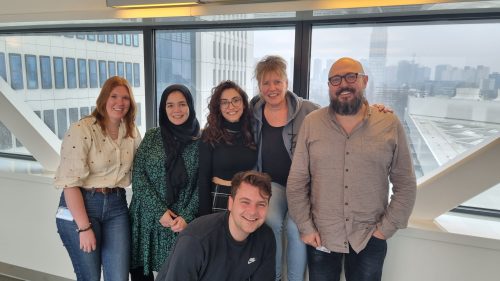
We study the molecular mechanisms of DNA repair in relation to disease
Our research focuses on:
- Nucleotide excision repair mechanisms
- Interstrand crosslink repair mechanisms
- Transcription-coupled DNA repair and transcription stress
- DNA repair organization in vivo and in differentiated cell types
- DNA repair disease mechanisms
- Cancer chemotherapeutics and DNA repair
On 6 dec 2024, Carlota Davó-Martínez succesfully defended her thesis. 
We contributed to a paper of the Vermeulen lab published in Nature Communications, identifying DDA1 as new regulatory subunit of the TC-NER E3 ubiquitin ligase CRL4-CSA.
We contributed to a paper of the Marteijn lab published in Nucleic Acids Research describing that the inability to process lesion-stalled RNA polymerase II may cause Cockayne syndrome.
On 27 June 2024, Alba Muniesa-Vargas succesfully defended her thesis. 
We published a paper in Nature Communications showing that prolonged TFIIH binding to nonexcised DNA damage causes severe neuronal and developmental failure. This can be prevented by depletion of XPA or TTDA, which stabilize TFIIH-DNA damage binding.
We collaborated on a paper of the Marteijn lab published in Nature Cell Biology showing that DNA-protein crosslinks are repaired by a novel transcription-coupled DNA repair pathway involving CSB and CRLCSA.
In Februari 2024, Romy Paap started as PhD student in our team.
We published a collaborative paper with Jana Slykova and Joanna Loizou in NAR Cancer showing that DDB2 and HMGA2 proteins promote the detection of oxaliplatin-DNA lesions and that cellular DDB2 levels are predictive of the survival of oxaliplatin-treated colorectal cancer patients.
We wrote a review published in DNA repair that describes new mechanistic and structural insight into the central function of TFIIH in nucleotide excision repair and lists all currently known TFIIH patients with their symptoms.
We contributed to a paper of the Vermeulen lab published in EMBO Molecular Medicine showing that trichothiodystrophy-causative mutations in TTDN1/MPLKIP cause DBR1 instability, affecting splicing and skin development.
We published a paper in Nucleic Acids Research describing a new method termed ‘Recovery of Protein Synthesis’ to assay transcription-coupled DNA repair activity in cells in tissues in vivo.
We published a paper in Nucleic Acids Research showing regulation of transcription silencing, R-loop processing and DNA repair by various SWI/SNF complexes at double strand breaks in transcribed genes.
In June 2023, Alya Kalkattwi joined our team as PhD student.
In May 2023, Ülkem Kaynak joined our team as PhD student.
We contributed to a paper published in Nature showing innate immune activation by accumulation of cytoplasmic RNA-DNA hybrids after R-loop processing.
We contributed to paper published in Nature Communications showing that PARP1 and PARP2 interact with XPC and regulate ALC1 for chromatin remodeling during GG-NER.
In July 2022, David Häckes joined our team as PhD student.
We published a review in Cellular and Molecular Life Sciences describing the function of XPG in nucleotide excision repair and other genome maintenance pathways.
We collaborated on a paper in Nature Communications showing that DDB2 and other NER proteins promote the repair of oxidative DNA lesions.
We published a paper in Communications Biology showing that C. elegans mutants of the gtf-2H5/TTDA subunit of TFIIH may be a useful model for studying pathogenic molecular mechanisms of trichothiodystrophy.
We contributed to a review published in Cellular and Molecular Life Sciences detailing DNA damage detection by GG-NER in chromatin.
We published our protocol detailing how UV survival assays in C. elegans can be used to distinguish between global genome and transcription-coupled nucleotide excision repair in STAR protocols.
We collaborated on a paper published in Nature Cell Biology showing that ELOF1 is a new transcription-coupled DNA repair factor.
We contributed to a paper published in Science Advances describing a role of SMARCAD1 in promoting replication fork stability.
Amazing Erasmus MC, an online magazine on everything that goes on in our host institute Erasmus MC, has published very nice short cover story in Dutch about our DNA repair work with C. elegans.
C2W, the online magazine of the Royal Netherlands Chemical Society, wrote a short article (originally in Dutch but here also in English) explaining our recent findings on tissue-specific DNA repair in C. elegans.
We published a paper in Cell Reports describing intriguing differences in DNA repair and DNA damage response in different tissues of the model organism C. elegans.
We published a paper in Nature Communications showing that DDB2 dissociation promotes DNA damage handover to XPC-TFIIH.
On 9 June 2020, Cristina Ribeiro-Silva successfully defended her thesis ‘Nucleotide excision repair through the looking glass’ online.
On 23 October 2019 Mariangela Sabatella succesfully defended her thesis entitled ‘When a cut makes the difference: DNA damage incision from human cells to C. elegans.‘
We collaboratively published a comprehensive review in Nature Reviews Molecular Cell Biology about the DNA damage response to transcription stress